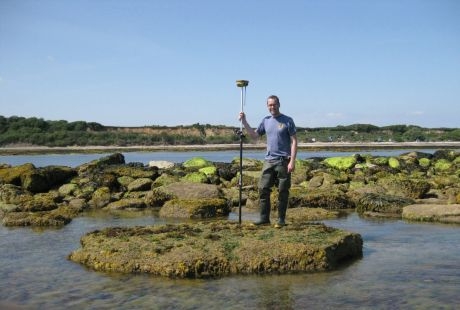

4 February 2019
3 min read
Boulders heavier than cars have been overturned and moved tens of metres by storms in one of Britain’s more sheltered waterways, new research has found.
It is the first time evidence has been found that moderate storm waves can move very large boulders even in the relatively calm waters of the Solent.
The research, by Linley Hastewell, in the University of Portsmouth’s School of the Environment, Geography and Geosciences, is published in Earth Surface Processes and Landforms.
He said: “I was surprised. Everyone I’ve talked to about it is surprised. The Solent is a relatively sheltered location which adds to the remarkable nature of what we are seeing here.
“Large boulders, some weighing between 5-10 tonnes, are being shifted in mild storms on the sheltered eastern side of the Isle of Wight.
“It’s a testament to the dynamic nature of our coasts and demonstrates that storm-driven waves have a far greater ability to erode and reshape the coastline than we previously realised.
It’s a testament to the dynamic nature of our coasts and demonstrates that storm-driven waves have a far greater ability to erode and reshape the coastline than we previously realised.
Linley Hastewell, School of the Environment, Geography and Geosciences
“The research suggests we may need to reassess our current understanding of storm wave hydrodynamics.”
Although the research was carried out on the Isle of Wight, the same results are likely to be reflected on rocky coasts globally, he said.
“These coastal locations, where land meets the ocean, are our first line of defence against the erosive forces associated with storm events. How these areas respond is important for the future management of rocky coasts. The data tells us that boulders are frequently moved some distance and often overturned even in relatively small storms, which until now had never been documented in such detail.”
The research team tracked 104 limestone boulders over three years by inserting radio frequency identification (RFID) tags inside them. The boulders were located near Bembridge, on the Isle of Wight, a site protected from large Atlantic waves and the prevailing winds.
These coastal locations, where land meets the ocean, are our first line of defence against the erosive forces associated with storm events. How these areas respond is important for the future management of rocky coasts. The data tells us that boulders are frequently moved some distance and often overturned even in relatively small storms, which until now had never been documented in such detail.
Linley Hastewell, School of the Environment, Geography and Geosciences
The tagged boulders varied in size from quarter of a metre to more than three metres in length. The RFID technique has been used before in beach pebbles, but it is the first time it has been used in boulders of such size.
The research identified that storms in 2016 flipped a five-tonne boulder, transporting it seven metres, and a boulder heavier than ten tonnes was moved over three metres.
People have long been aware of coasts being ravaged by storms, Mr Hastewell said, but the main difference is that sand and pebbles can be replaced, but detached boulders cannot which makes rocky coasts more vulnerable to erosion.
“With the anticipated increase and intensity of storm activity from climate change this could pose a real issue in the future,” he said. “It’s important to be able to establish the frequency and extent to which material is being removed and transported.
With the anticipated increase and intensity of storm activity from climate change this could pose a real issue in the future,” he said. “It’s important to be able to establish the frequency and extent to which material is being removed and transported.
Linley Hastewell, School of the Environment, Geography and Geosciences
“Also, large coastal boulders act as indicators of the wave force that enabled transport and deposition. This means researchers can use boulders as signatures of past events such as historic tsunamis or extreme storm events which can then be incorporated into risk calculations for vulnerable coastal communities.”
He said that monitoring the movement of coastal boulders would provide a clearer understanding of how our coastline responds to storm activity which will help inform policy makers responsible for managing coastal environments.
